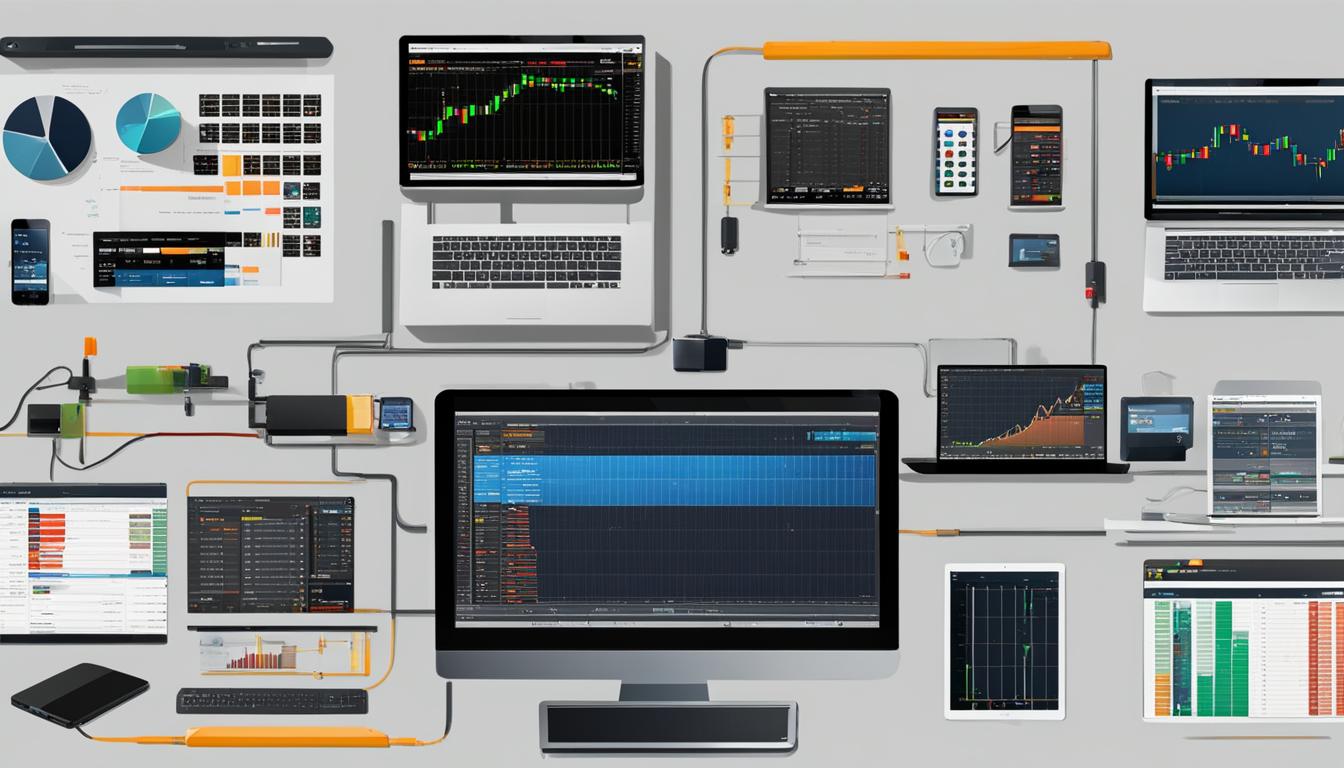
Introduction to Leverage Trading
Leverage trading is a powerful tool in the financial markets that allows traders to control larger positions with a relatively small amount of capital. This strategy involves borrowing funds from a broker to increase the potential return on investment. Understanding the definition of leverage in trading is crucial for any trader looking to maximize their gains.
Leverage amplifies both potential profits and losses, making it a double-edged sword. For example, if you have $1,000 and use 10:1 leverage, you can control a position worth $10,000. A 1% gain on this position would yield a $100 profit instead of just $10. However, the same leverage also means that a 1% loss results in a $100 loss.
Why Leverage is Important:
- Increased Market Exposure: Leverage allows traders to gain exposure to larger market positions without needing significant capital.
- Potential for Higher Returns: By controlling more substantial positions, traders can achieve higher returns compared to trading with their own funds alone.
Understanding leverage trading not only opens up new opportunities but also necessitates a thorough grasp of risk management strategies. It’s essential for traders to educate themselves about the risks involved and employ effective tools to mitigate potential losses.
For those new to trading or looking for more information, consider exploring resources on open interest in option contracts which unveils the hidden power of open interest in option contracts by providing insights into market trends and investor sentiment for smarter investment decisions. Additionally, learning about broker scams is crucial to safeguard your investments as it reveals the true nature of broker scams in the U.S., offering tips on how to keep your investments safe.
Understanding Leverage in Trading
Leverage in trading refers to the use of borrowed funds to amplify potential returns on an investment. When you trade using leverage, you are essentially using a small amount of your own capital and borrowing the rest from your broker. This allows you to open larger positions than you could with your own funds alone.
How Leverage Works in Trading
Leverage amplifies both gains and losses. For example, if you have a leverage ratio of 10:1, this means that for every $1 of your own money, you can control $10 worth of assets.
Consider a hypothetical scenario:
- You decide to trade a stock priced at $100 per share.
- With a 10:1 leverage, you only need $10 to control one share.
- If the stock price rises by 10%, from $100 to $110, your return on investment (ROI) would be 100% because your $10 has earned you an additional $10.
However, leverage also magnifies losses:
- If the stock price drops by 10%, from $100 to $90, your loss would be 100%, as your initial $10 investment is completely wiped out.
This dual-edged nature makes understanding and managing leverage crucial for any trader. To further enhance risk management skills, it’s important to grasp the differences between [systematic and unsystematic risk](https://www.fxoptions.com/systematic-vs-unsystematic-risk). Applying strategies that consider these concepts can significantly improve trading outcomes.
Leverage trading offers significant opportunities but comes with substantial risks. For instance, exploring financial instruments like [put options](https://www.fxoptions.com/put-option) can provide valuable insights into advanced strategies which mitigate some of these risks while maximizing profits.
To delve deeper into the concept of leverage, you can refer to this informative article on Investopedia.
The Importance of Risk Management in Leverage Trading
Risk management is crucial when it comes to leverage trading. With leverage, your potential gains and losses are multiplied. This means that you need effective strategies in place to protect your money and increase your chances of making profits in the long run.
Key Risk Management Strategies
1. Stop-Loss Orders
- A stop-loss order is a predetermined point at which you will exit a trade to limit losses. For example, if you buy a stock at $100 and set a stop-loss order at $90, the trade will automatically close if the price drops to $90.
- This tool helps prevent impulsive decision-making during times of market volatility.
2. Position Sizing Techniques
- Position sizing involves deciding how much money you’re willing to risk on a single trade. By using proper position sizing, you can ensure that no single trade has a significant impact on your overall investment portfolio.
- One common rule is the 1% rule: never risk more than 1% of your trading capital on any single trade. However, you can adjust this strategy based on your personal risk tolerance and current market conditions.
Why Risk Management Matters
Having effective risk management strategies in place allows traders to stay active in the market for longer periods of time. Without these strategies, even just a few poorly managed trades can result in significant losses that quickly eat away at your trading capital.
By using tools like stop-loss orders and position sizing techniques, you can have structured methods for managing risks and protecting your investments.
“Effective risk management allows traders to stay in the game longer.”
These strategies are designed to help you:
- Minimize potential losses
- Maximize the likelihood of long-term success in leverage trading environments
To make better financial decisions and further improve your trading strategies, consider exploring these resources:
And remember, knowledge is power. The more you understand about the world of finance and trading, the better equipped you’ll be to navigate its complexities.
Different Financial Instruments for Leveraged Trading
Leverage trading offers numerous opportunities across various financial markets. Each market has its unique characteristics, making them suitable for different trading strategies.
Forex
The forex market is a popular choice for leveraged trading due to its high liquidity and 24-hour availability. Leverage ratios in forex can be particularly high, often reaching up to 100:1 or more, which enables traders to control large positions with relatively small capital. This market is ideal for those who favor short-term trading strategies such as day trading and scalping.
Commodities
Trading commodities like gold, oil, and agricultural products also provides leverage opportunities. These markets are influenced by supply-and-demand dynamics, geopolitical events, and natural phenomena. Leveraged commodity trading allows traders to potentially profit from price movements without needing to own the physical asset.
Stocks
Leverage in stock trading is typically offered through margin accounts. Traders can borrow funds from their broker to purchase more shares than they could with their available capital. While this can amplify gains if the stock price rises, it also increases the potential for significant losses if the price falls. Margin requirements and leverage ratios vary depending on the broker and regulatory guidelines.
Cryptocurrencies
Cryptocurrency markets offer substantial leverage options, often up to 100x or more. Trading digital currencies like Bitcoin and Ethereum on margin can be highly lucrative but also extremely volatile. It is crucial to have a robust risk management strategy when engaging in leveraged cryptocurrency trading due to the market’s unpredictability.
For those transitioning from paper trading to real money trading, understanding these financial instruments’ intricacies is essential, as it involves testing your comfort zone and weighing the pros and cons of paper vs real money trading.
Exploring these different markets provides you with various avenues to apply leveraged trading strategies effectively. Each market presents its own set of challenges and opportunities, making it important to choose the one that aligns best with your risk tolerance and trading objectives.
If you are interested in options trading, it’s worth noting how the market has changed over the last decades. Understanding these changes can inform your leveraged trading strategies and potentially boost your profits.
Pros and Cons of Using Leverage in the Markets
Leverage trading can offer several compelling benefits for traders looking to maximize their market exposure:
- Amplified Gains: By using leverage, you can control a larger position with a smaller amount of capital. This means potential profits are magnified relative to the initial investment.
- Increased Market Access: Leverage enables traders to participate in markets that might otherwise be out of reach due to high capital requirements. This includes forex, commodities, stocks, and cryptocurrencies.
- Flexibility and Diversification: Utilizing leverage allows for greater flexibility in trading strategies and portfolio diversification. Traders can allocate funds across various assets while still maintaining significant market exposure.
However, it’s important to be aware of the risks associated with leverage trading:
- Magnified Losses: Just as leverage can amplify gains, it can also amplify losses. A small adverse price movement can result in substantial financial loss.
- Margin Calls: If the market moves against your leveraged position, you may face a margin call, requiring additional funds to maintain your position. Failure to meet this requirement can result in the liquidation of your position at a loss.
- Emotional Stress: The high stakes involved in leveraged trading can lead to emotional stress and impulsive decision-making. Effective risk management strategies become critical to mitigate this.
Understanding both the benefits and risks of leverage trading is crucial for making informed decisions. For further insights into the complexities of leveraged trading and market updates, resources such as this recent stock market news article from FxOptions provide valuable information on stock market trends.
In addition to understanding leveraging itself, it’s also important for traders to grasp key concepts related to options trading like options settlement, which explains how contracts are settled, and the functioning of options exchanges, shedding light on who they are and how they operate. These insights can significantly enhance their trading strategies and overall decision-making process.
Regulatory Framework for Leverage Trading
Regulators play a crucial role in overseeing leveraged transactions and ensuring investor protection. They do this by setting margin requirements and leverage limits to reduce the risks of high leverage.
Key Aspects of Regulation:
- Margin Requirements: Regulators such as the SEC in the United States or ESMA in Europe enforce specific margin requirements. These rules state the minimum amount of equity a trader must have in their account. The purpose is to prevent excessive borrowing and safeguard both traders and brokers from significant losses.
- Leverage Limits: Different financial markets have their own leverage limits. For example, in forex trading, regulatory bodies might set a maximum leverage ratio of 30:1 for retail clients, while professional traders can have higher ratios. These limits are put in place to lower the chances of massive losses.
Safeguards Imposed by Regulators:
- Periodic Audits: Brokers and financial institutions undergo regular audits to ensure they are following regulatory standards. This ongoing supervision helps maintain the fairness of the market.
- Mandatory Disclosures: Traders must be fully aware of the risks involved in leveraged trading. It is essential for brokers to provide clear information about potential losses.
Understanding these regulations is vital when participating in leveraged trading. Knowing what responsibilities brokers have can assist you in avoiding common mistakes.
Determining Optimal Leverage Levels
Choosing the right leverage level can significantly impact the success of your trading strategy. Several factors come into play when determining the optimal leverage ratio for your trades.
Factors to Consider
- Market Volatility: High volatility markets require lower leverage to effectively manage risk, while less volatile markets might allow for higher leverage. Understanding the contrast between historical volatility vs implied volatility can provide valuable insights into shaping your trading strategy.
- Trading Experience: Beginners should start with lower leverage until they gain more experience and confidence. On the other hand, more seasoned traders may experiment with higher leverage levels.
- Risk Tolerance: Assessing your risk tolerance is crucial. If you have a low risk tolerance, using minimal leverage is advisable.
- Capital Available: The amount of capital you have influences your leverage choice. Larger capital reserves allow for higher leverage, while smaller reserves necessitate cautious use of leverage.
- Trading Strategy: Different strategies require different leverage levels. For instance, momentum trading techniques often involve varying degrees of leverage depending on market conditions and strategy specifics.
- Regulatory Restrictions: Be aware of the regulatory limitations on leverage in your jurisdiction as these can vary widely.
By thoroughly evaluating these factors, you can determine an optimal leverage ratio that aligns with your trading goals and risk management strategies. Understanding key concepts such as Call vs Put can further enhance your decision-making process in options trading.
Conclusion
Engaging in leveraged trading presents both substantial risks and rewards. Understanding how leverage works and implementing effective risk management strategies is crucial for traders who want to succeed in this space.
Responsible and informed practices are your best allies. Equip yourself with knowledge, utilize tools like stop-loss orders, and always consider optimal leverage levels tailored to your trading strategy.
For more insights on managing trading risks, you can explore options quotes to understand various components of an option quote, which is a crucial aspect of options trading. Moreover, to further enhance your portfolio, you may want to consider incorporating neutral options strategies, which provide a winning edge in any market conditions. These strategies are designed to bolster your portfolio and offer flexibility in the complex world of trading.
If you’re specifically interested in the influence of trading halts on options trading and how to mitigate associated risks, we have a comprehensive guide on the influence of trading halts on options trading that can help you navigate this aspect successfully.
FAQs (Frequently Asked Questions)
What is leverage trading?
Leverage trading involves using borrowed funds to increase the potential return of an investment. It allows traders to control a larger position with a smaller amount of capital.
How does leverage work in trading?
Leverage works by amplifying both potential gains and losses in trades. For example, a 2:1 leverage means that for every $1 of actual capital, the trader can control $2 in assets.
Why is risk management important in leverage trading?
Effective risk management is crucial when utilizing leverage because it helps traders mitigate potential losses. Key risk management tools to consider include stop-loss orders and position sizing techniques.
What are the different financial instruments for leveraged trading?
The various markets that offer opportunities for leveraged trades include forex, commodities, stocks, and cryptocurrencies. Each market presents its own unique set of risks and potential rewards.
What are the pros and cons of using leverage in the markets?
Using leverage can amplify potential gains, but it also increases the risk of significant losses. Traders should carefully weigh the advantages and pitfalls associated with trading on margin.
What is the regulatory framework for leverage trading?
Regulators play a crucial role in overseeing leveraged transactions and imposing necessary safeguards to protect investors. This includes setting margin requirements and leverage limits to ensure stability in the financial markets.
How do you determine optimal leverage levels for trades?
When choosing an appropriate leverage level for trades, factors such as risk tolerance, market volatility, and individual trading strategies should be carefully considered to determine the optimal level of leverage.
What is the conclusion on leverage trading risks and rewards?
In conclusion, it is important for traders to engage in responsible and informed practices when utilizing leveraged trading strategies. While it offers potential rewards, it also carries inherent risks that must be managed effectively.







